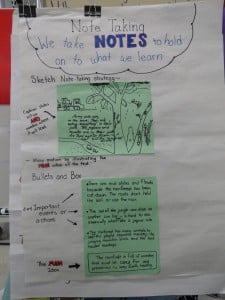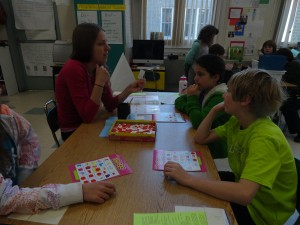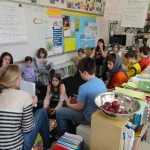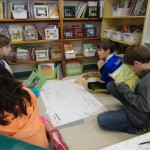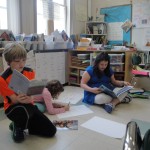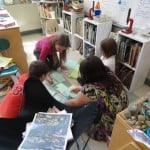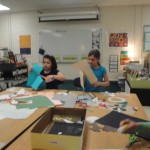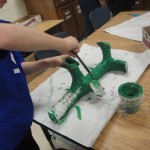 We have had a busy week. We are researching state wonders and habitats. We are learning about fractions and more about subtraction. We are focusing in on punctuation and the conventions of writing as we draft summaries, informational pieces and book reviews. Our book reviews were posted on our blogs yesterday. We also have plans to publish them as a summer reading guide for home and out in the hall to see if we can get other kids to comment on them as well. Three of our four first book clubs finished this week too.
We have had a busy week. We are researching state wonders and habitats. We are learning about fractions and more about subtraction. We are focusing in on punctuation and the conventions of writing as we draft summaries, informational pieces and book reviews. Our book reviews were posted on our blogs yesterday. We also have plans to publish them as a summer reading guide for home and out in the hall to see if we can get other kids to comment on them as well. Three of our four first book clubs finished this week too.
On top of all this our social and emotional learning focus has been about developing self-awareness. What are we doing to support our learning and to help ourselves meet deadlines and learning goals. Our days are certainly full. I know the afternoons and evenings are full as well. Your children are busy and tired. They are excited and worried about the end of the school year coming. Putting all these feelings and activities together means that the children have to be focused and on task most of the time. They are working to do their best as time flows on.
Reading and Understanding Creating Personal Summaries
This week we continued to learn about summaries. After exploring a lot of ideas and examples, we have come up with a three part guide. A summary shares the main idea, a couple of details that illustrate the main idea and finally the thoughts and feelings we have about the text. The last part is the most important because it is the most individual. It also shares and shows how a person was changed by what was read or heard. So, if I’m reading The Lunch Lady I might be thinking about how creative the author is to imagine all the kitchen gadgets like the taco goggles or the spatula helicopter, but if I’m reading A Walk to School I might be noticing that the Catholic children walking through the Protestant neighborhood in Northern Ireland is similar to the struggle that Martin Luther King led. We are working to slow down and really think about what we are reading so we are more aware of our understanding and how we can grow and change.
Note Taking Strategies
We are reading an informational book during our chapter read aloud time. It is about the rainforest – a main habitat type that we do not have in our country. We are learning about different note-taking techniques. One is technique is to sketch the motion or action of the text. Each picture should have some indication that change is happening and should have a caption that explains what the action is and where it is leading. This is a stretch from the static sketch of one thing mentioned in the text. It is challenging the children to engage with the reading and really think about what they are hearing.
A second strategy is called Bullet and Box. With this strategy the children collect and bullet information or main events in the part of the text they are reading or hearing. At the end they are writing a summary statement and placing a box around it. Again this is asking them to listen carefully and to thinking beyond the text. They are learning to connect and synthesize ideas.
This is a challenge, but many of the children have realized they are remembering more about the book because of the work. Many have also realized they are thinking and wondering more about the information they are learning.
Fractions – Recipes and Number Lines
One of the ways we have been exploring fractions is to look at different recipes. We have been doubling them and cutting them in half. Through this work together we have again noticed that with fractions bigger numbers mean smaller amounts. We are learning how to add fractions with like denominators and how we can divide them into even smaller amounts. We have played the Fraction Barrier game in class and a fraction bingo game to help the children become more comfortable with what fractions are. Finally we have been working to use fractions on number lines with different ending points. That way we know that 1/4 of 100 is 25, but 1/4 of 336 is 84. Fractions certainly challenge us to think in different ways. They are intuitive in real-life situations, but confusing when working with paper and pencil. Any chances you have to share fraction work through cooking or building, crafting or sewing with your children will certainly add to their understanding.
Basic Facts
This week, as indicated on the homework summary, the children took three timed test for the basic facts they have been working to master through all their practice this year at school and home. We all agreed subtraction might be most challenging, next was multiplication because it was so new and then addition because it is most familiar. Proficiency, or meeting the standard, is being able to correctly solve 65 of 70 problems in 7 minutes or less. Many of the children have reached that goal with at least one operation. A few were able to meet it with two. In all the busyness of spring I hope the children will be able to fit in some fact practice although I do understand this is a real challenge at this time of year.
Bits and Pieces
- The children seem to be enjoying learning about their states. They are creating comic in Technology and getting ready to share what we know on our blogs.
- We have formed four Naturalist Teams. In then the children are learning about the main habitats in our country. They will create habitat displays to teach others about them.
- We are also organizing ourselves and our work for end-of-the-year student-led conferences.
